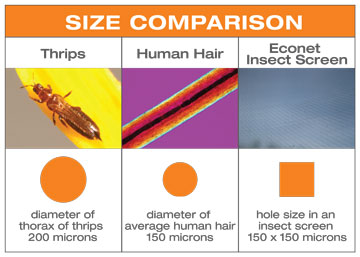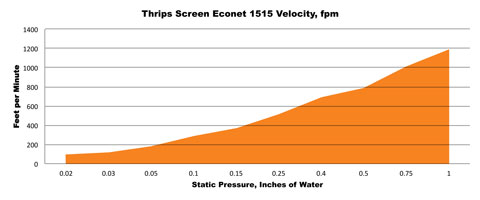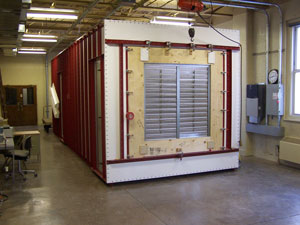8/28/2013
Keep Thrips Out with Screening
Kurt Parbst

Western flower thrips (
Frankliniella occidentalis) are nasty greenhouse pests. They feed on many kinds of floral and vegetable plants, can create great damage, carry viruses and are spread readily across the continent via our plant and materials deliveries. Thrips are also tiny and very mobile, and they can protect themselves very well deep inside flowers. They lay their eggs in leaf and flower tissue, where they’re well protected, and the pupal stage is protected even in soil media.
The reproductive cycle is, therefore, difficult to break. No pesticide provides complete control and thrips have proven to be quite difficult to effectively control with insecticides alone. An integrated approach is necessary, including preventative biological strategy such as predatory insects, mites and nematodes; monitoring with sticky cards; and well-planned responsive action with pesticides minding best practices with timing and coverage.
Still, thrips complaints seem to be escalating. Their population growth depends mainly on temperature, expanding most rapidly around 86F (30C). Perhaps populations are exacerbated by relatively warm winters and an incomplete frost kill. But as thrips can overwinter in greenhouses, perhaps it’s related to a combination of poor understanding of prevention and control and perhaps partly due to pesticide resistances.
The acceptable population size of Western flower thrips is no population. Therefore, prevention is, in essence, the cure. This includes not inviting them in with purchased raw materials, such as plugs and cuttings, and screening out ambient populations. Using insect screens for thrips exclusion is rather simple, but the design and operation require attention.
It’s a good idea for most growers afflicted significantly by Western flower thrips to use micro screening. It’s absolutely necessary for those shipping plant materials, such as vegetative cuttings to other growers, to be rooted and finished. This is especially true when any insects found at a border crossing by federal inspectors put a shipment and production schedule at risk.
Details about screening
In the early 1990s, significant investigations were made regarding insect micro screening and it was reported that, due to their slender size, thrips are excluded only by screens with very fine holes. The recommended maximum hole size to exclude the Western flower thrips is 192 micrometers (μm). Given that the diameter of a human hair ranges from 17 to 181 μm, this indeed requires a fine screen.
Steps to Take
• Select screen hole size for smallest insect of interest. For Western flower thrips, a maximum width and length of the hole should be less than 192 μm.
• Evaluate areas to screen: inlet, exhaust, personnel entry
• Mechanical ventilation: select area of screen according to pressure velocity relationship
• Natural ventilation: select area of screen according to the discharge coefficient and acceptable decrease in vent area
• Mount so the screen will stay dry in rain, as the screening pores will be filled with water held in with capillary forces
• Maintain: repair holes immediately, clean at least annually
Due to the solid space of a very fine screen, care must be taken to significantly reduce the area of ventilation air inlets, which would reduce volumetric air flow rates and drive up air temperature. Greenhouses may be mechanically and/or passively ventilated to control overheating and the two types require a different approach in designing the required screen area.
Mechanical ventilation
Mechanical negative pressure ventilation systems for greenhouses are rather simple and the most common. Fans are mounted in a wall to create a pressure difference across the wall. Air inlets are mounted on the opposite wall to relieve that pressure by introducing fresh outside air, which replaces the air that has picked up heat in the greenhouse. This heated air is then exhausted through the fans.
An inlet free of obstruction creates little resistance. An inlet impeded by an insect screen or cooling pad will create a resistance for the fans to work against. The greater the resistance, the lesser the air exchange rate and the higher the greenhouse temperature rises during sunny periods. This resistance must be considered so that the fans are able to operate within their design parameters. This ensures enough air is exchanged to keep the temperature rises within ranges conducive to plant growth and worker comfort and to let the fan system operate efficiently and cost effectively.

A review of the ventilation system—including the fan type, maximum airflow capacity and inlet area—will reveal how much surface area of insect screen is needed to limit the resistance that will be created by the screen. This is possible by referring to the pressure velocity characteristics that are unique to each insect screen. Pressure-velocity curves are developed by evaluating insect screens in a wind tunnel.

It’s important to screen all of the relevant points of entry for thrips and to take each screen crossing into account in the design. This, of course, means the air inlets first and foremost, but also entries where workers and plants and equipment pass through. Hitchhiking pests are often overlooked and a vestibule containing an air shower is a good idea to blow off pests riding on hair or clothing.
When ventilation design is made, often the insect screen area that’s needed is greater than the area of the inlet. In this case, additional structure is often required to support the screen. With proper design, thrips screens can be rather easily and cost effectively adapted to any mechanically ventilated house.
Natural ventilation
Naturally ventilated greenhouses are trickier to deal with than those with fans. By nature, passive houses are reliant upon not only good design, but also both wind and sun to ventilate properly. Generally speaking, naturally ventilated greenhouses well designed to receive thrips screens are tall, with air inlets low and exhaust vents high. The vents will be large, relative to the floor area, to accommodate the vent area reduction associated with the addition of screens.
Screening an already under-ventilated greenhouse in a warm climate will only invite overheating challenges, including triggering more rapid biological activity. Selecting the appropriate area of thrips screen requires knowledge of the screen’s discharge coefficient, which is also determined via wind tunnel testing. In general, for a given hole size, you want a screen with the highest discharge coefficient possible. The higher the discharge coefficient, the less screen area that’ll be needed to achieve an acceptable decline in ventilation rate compared with the unscreened case and vice versa.
Naturally ventilated houses may be screened effectively as well, but it’s easier to account for the screen in the initial structure and vent design than to retrofit existing houses.
Good advice
A well-designed screen system is the best prevention against the establishment of a Western flower thrips population. However, operation and maintenance also are important. Make sure workers follow a protocol that allows them to safely enter and exit the greenhouse with their tools without bringing thrips in through doors or on their hair or clothes.
The holes in a thrips screen are very small. Screening panels with any damage or tears in the screen are large invitations to entry and should be replaced or repaired immediately. Repairs can be accomplished by hand stitching a patch over the tear and sealing the perimeter with silicone caulking.
Screens should be brushed with soap and water and rinsed at least annually to limit the accumulation of hole clogging dust and debris. High-pressure washing may be used on some screens, provided it isn’t enough pressure to alter the hole size.
For more information, take a look at the video at
http://tinyurl.com/thripsscreens.
GT
Special thanks to Andor Gerendas and Byron Calderon of Paul Ecke Guatemala and to Kevin Cullum of Koppert for contributions to this article.
Kurt Parbst is president of Ludvig Svensson Inc. He can be reached at (704) 357-0460 or kurt@svenssonamericas.com.
Los trips occidentales de las flores (
Frankliniella occidentalis) son una complicada plaga de los invernaderos, pues se alimentan de muchos tipos de flores y hortalizas, producen un severo daño directo, portan virus, y son diseminados fácilmente a través del continente en despachos de plantas y material vegetal. Adicionalmente son diminutos y muy móviles, y pueden protegerse enterrándose profundamente dentro de las flores. Depositan huevos sobre los tejidos foliares y florales donde quedan bien protegidos, y el estadio pupal ocurre bajo la protección del suelo o sustrato.
El ciclo reproductivo es por lo tanto difícil de romper. Ningún pesticida ofrece un control completo de los trips, y de hecho resulta muy difícil controlar este insecto solamente con insecticidas, siendo necesario adoptar un enfoque integrado que incluya una estrategia biológica preventiva, por ejemplo con insectos, ácaros y nematodos depredadores; monitoreo con trampas pegajosas; y una acción de respuesta bien planeada con pesticidas, observando buenas prácticas y teniendo en cuenta la programación de las aspersiones y el cubrimiento logrado.
Aún así, las quejas por la presencia de trips parecen estar aumentando. El crecimiento de las poblaciones depende principalmente de la temperatura, siendo más rápido alrededor de los 86F (30C). Es posible que las poblaciones sean exacerbadas por los inviernos relativamente cálidos y cuando la muerte por bajas temperaturas es incompleta; pero como los trips pueden pasar el invierno en los invernaderos, también es posible que estemos frente a una pobre comprensión de su prevención y control y aún de una resistencia parcial a algunos pesticidas.
El tamaño aceptable de una población de trips occidentales de las flores es cero, por lo que en esencia, la prevención es la única solución. Esto incluye evitar su ingreso en materias primas adquiridas – como esquejes o plugs, y usar mallas para excluirlos de ciertos ambientes. El uso de mallas anti-insectos para excluir los trips es bastante simple, pero su diseño y operación requieren atención.
Para la mayoría de los productores afectados por estos trips es buena idea usar micro-enmallados. Para quienes producen y despachan material vegetal como esquejes vegetativos listos para enraizar, esta medida resulta esencial. Esto es particularmente cierto cuando los insectos son hallados por inspectores en cualquier paso fronterizo, ya que ello pone en riesgo la producción.
Detalles del enmallado
A comienzos de los 1990s se realizaron investigaciones significativas sobre el micro enmallado, encontrándose que debido al reducido tamaño de los trips, sólo es posible excluirlos con mallas de orificios muy pequeños. El tamaño máximo recomendado para evitar el ingreso de los trips occidentales de las flores es de 192 micrómetros (m). Siendo que el diámetro de un pelo humano varía entre 17 y 181 m, realmente se trata de una malla muy fina.
Dadas las características – casi sólidas – de una malla tan fina, es importante asegurar que no se reduzca significativamente la ventilación, pues el flujo volumétrico de aire se reduce sustancialmente lo que hace que suba la temperatura ambiente. Los invernaderos se pueden ventilar mecánica y /o pasivamente para controlar el sobrecalentamiento, pero en cada caso se requiere un enfoque diferente al momento de diseñar el área de enmallado que es requerida.
Ventilación mecánica
Los sistemas mecánicos de ventilación para invernadero por presión negativa son más bien simples, y los más comunes. Se montan ventiladores sobre una pared para crear un diferencial de presión a través de las misma, con puntos de ingreso de aire en la pared opuesta, para aliviar dicha presión mediante la introducción de aire fresco desde el exterior; esto reemplaza el aire caliente del invernadero, que es luego expulsado a través de los ventiladores.
Un punto de entrada de aire que se encuentre libre de obstrucciones crea poca resistencia, pero un punto tapado por una malla o almohadilla de enfriamiento creará una resistencia contra la cual deben operar los ventiladores. Entre mayor sea la resistencia menor será el intercambio de aire y mayor el grado al cual asciende la temperatura durante períodos soleados. Esta resistencia debe ser tenida en cuenta, de manera que los ventiladores puedan operar dentro de los parámetros para los cuales han sido diseñados, asegurando que se intercambie suficiente aire para mantener los picos de temperatura dentro de rangos que sean conducentes al crecimiento de las plantas y a la comodidad de los operarios, a la vez que permitan al sistema de ventilación operar eficientemente y en un buen nivel de costo/beneficio.
Una buena revisión del sistema de ventilación—incluyendo el tipo de ventilador, la capacidad máxima de flujo de aire y el área de puntos de entrada—indicará el área de malla anti-insectos que es necesaria para limitar la resistencia creada por la malla. Esto se debe hacer en consideración a las características de presión de velocidad, únicas de cada tipo de malla. Las curvas de velocidad de presión se desarrollan evaluando las mallas dentro de un túnel de viento.
Es importante evaluar todos los puntos relevantes de entrada para los trips y considerar cada cruce de mallas en el diseño. Esto por supuesto incluye principalmente los puntos de entrada de aire, pero también las entradas a través de las cuales ingresan los operarios y equipos. Las plagas “polizontes” con frecuencia pasan desapercibidas; instalar un vestíbulo con una ducha de aire es una buena idea para eliminar plagas que se encuentren sobre la ropa o el cabello.
Cuando se diseña la ventilación, con frecuencia se encuentra que el área de malla anti-insectos que se necesita es mayor que el área del punto de entrada, de manera que se requiere estructura adicional para soportar la malla. Con un diseño apropiado, las mallas anti-trips pueden ser adaptadas de manera relativamente fácil y efectiva a cualquier invernadero con ventilación mecánica.
Ventilación natural
Los invernaderos con ventilación natural son más difíciles de manejar que aquellos que cuentan con ventiladores. Por naturaleza, los invernaderos pasivos dependen no solamente de un buen diseño, sino del viento y el sol para que haya una ventilación adecuada. En términos generales, los invernaderos con ventilación natural que están bien diseñados para instalar mallas anti- trips son altos, con puntos de ingreso de aire bajos y puntos de escape altos. Las ventilaciones deben ser grandes en relación con el área de suelo, para acomodar la reducción en la ventilación al instalar las mallas.
El enmallado de un invernadero con ventilación insuficiente en un clima cálido solamente traerá retos asociados al sobrecalentamiento, incluyendo una actividad biológica mayor en los trips. La selección de un área apropiada de malla requiere conocer el coeficiente de descarga de la malla, que también se determina mediante pruebas en túnel de viento. En general, para un tamaño de orificio determinado, se busca una malla con el coeficiente de descarga más alto posible. Entre mayor sea dicho coeficiente menor será el área de malla requerida para lograr una disminución aceptable en la tasa de ventilación, en comparación con el caso sin malla, y vice versa.
Los invernaderos con ventilación natural también pueden ser enmallados de manera eficiente, pero es más fácil tener en cuenta la malla en la estructura inicial, que tener que hacer ajustes más adelante.
Un buen consejo
Un sistema de enmallado bien diseñado ofrece la mejor prevención contra el establecimiento de una población de trips occidentales de las flores. Sin embargo, su operación y mantenimiento también son importantes. Asegúrese de que los operarios sigan un protocolo que les permita entrar y salir de los invernaderos con su herramienta de forma segura, sin entrar trips en el pelo o vestido.
Los orificios de una malla anti-trips son muy pequeños. Los paneles de enmallado con daños o rasgaduras son una gran invitación al ingreso de los insectos y deben ser reparados o reemplazados de inmediato ya sea zurciendo un parche sobre la malla o sellándolo con silicona.
Las mallas deben cepillarse y enjuagarse con agua y jabón al menos una vez al año, para limitar la acumulación de polvo y residuos que taponan los orificios. Se puede usar un lavado a alta presión siempre y cuando no altere el tamaño de los orificios de la malla.
Para mayor información observe el video que se encuentra en
http://tinyurl.com/thripsscreens.
GT
Agradecimientos especiales a Andor Gerendas y Byron Calderon de Paul Ecke Guatemala y a Kevin Cullum de Koppert por sus contribuciones a este artículo.
Kurt Parbst es presidente de Ludvig Svensson Inc. Puede ser contactado en el teléfono 1 (704) 357-0460 o al correo kurt@svenssonamericas.com.
Pasos a Seguir
- Seleccione el tamaño de los orificios de la malla de acuerdo con el insecto de interés más pequeño. Para los trips occidentales de las flores, el ancho y largo máximo de los orificios debe ser menor a 192 m.
- Evalúe las áreas a enmallar: entrada, expulsión y entrada de personal
- Ventilación mecánica: seleccione el área de enmallado según la relación de velocidad de presión
- Ventilación natural: seleccione el área de enmallado según el coeficiente de descarga y una acceptable disminución en el área de ventilación
- Monte la malla de manera que permanezca seca cuando llueve, pues los poros se llenarán de agua que permanece allí como resultado de las fuerzas capilares
- Mantenimiento: repare los orificios inmediatamente, y haga una limpieza cuando menos anual